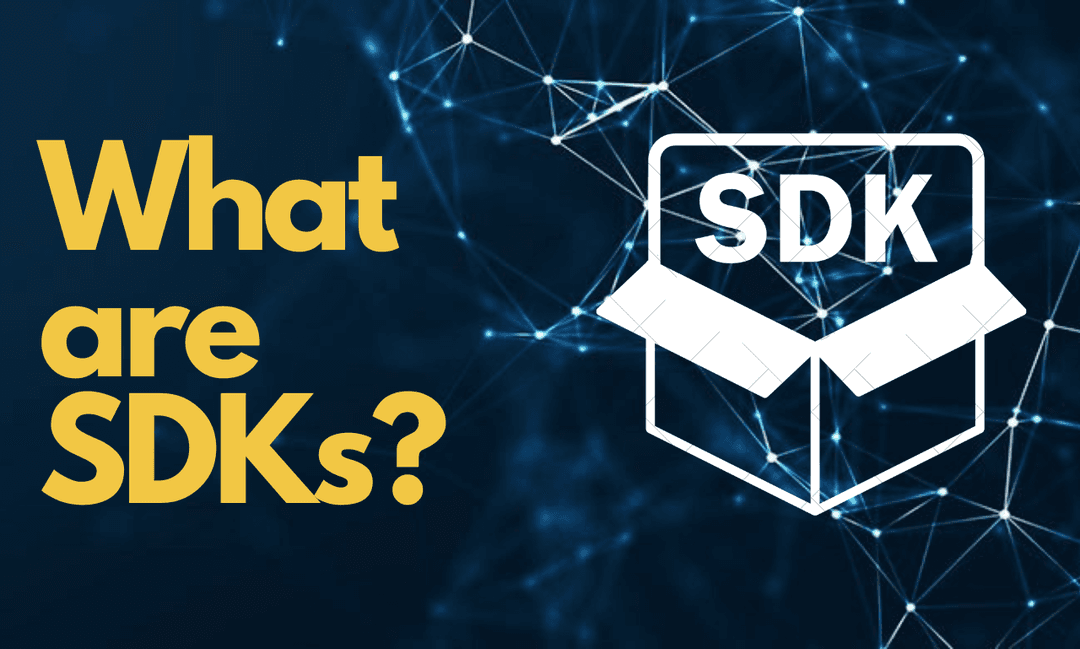
It’s impossible to deny the fact that software development is constantly growing and evolving. As software engineers, there are a lot of things we need to learn, trends to catch up with, and lots of codes to write.
To simplify the process of software dev, something is needed - Software Development Kits (SDKs). SDKs provide developers with a set of tools, libraries, documentation, and code samples that enable them to create applications for specific platforms or integrate with particular services more efficiently.
The importance of SDKs cannot be overstated. They not only save time but also ensure consistency and reliability in the development process, reducing the margin for error. As businesses strive to deliver seamless and robust digital experiences, the demand for high-quality SDKs has surged. However, manually creating and maintaining SDKs can be a daunting and resource-intensive task.
This is where SDK generation tools come into play. These tools automate the process of generating SDKs, allowing developers to focus on building features rather than managing the underlying code infrastructure. With many SDK generation tools available today, each offering unique features and benefits, it can be challenging to choose the right one for your needs.
This article will explore some of the best tools for generating SDKs. We will dive into some of the features, advantages, and use cases of each tool, providing you with a comprehensive guide to help you make an informed decision. Whether you are a seasoned developer or a newcomer to the field, this guide will equip you with the knowledge you need to leverage SDK generation tools effectively.
So without further ado, let’s dive in!
What is SDK Generation?
SDK generation refers to the process of automatically creating Software Development Kits (SDKs) from a set of specifications or APIs. This process leverages tools that parse API definitions, typically written in formats like OpenAPI or Swagger, and generate SDKs in various programming languages. These SDKs include pre-written code that developers can use to interact with APIs seamlessly, reducing the need for manual coding and ensuring that integrations are both consistent and reliable.
Benefits of Using SDK Generators
You guessed it, there’ll always be benefits of generating SDKs. let’s explore some of them below:
Time Savings:
Manually creating SDKs can be a time-consuming endeavor, especially when dealing with complex APIs or multiple programming languages. SDK generators automate this process, significantly reducing the time required to produce a fully functional SDK. This allows development teams to allocate their resources more efficiently, focusing on core product development and innovation.Consistency and Reliability:
SDK generators ensure that the generated code is consistent and adheres to best practices. This consistency is crucial for maintaining the quality and reliability of the SDKs. Automated tools can also quickly update SDKs when there are changes to the underlying API, ensuring that developers always have access to the latest and most accurate code.Support for Multiple Languages:
One of the significant advantages of SDK generators is their ability to support multiple programming languages. This feature is particularly beneficial for companies that need to provide SDKs for various platforms (e.g., Java, Python, JavaScript). By using an SDK generator, organizations can create and maintain SDKs in multiple languages without duplicating effort.
Key Considerations When Choosing an SDK Generator:
Compatibility with API Specifications:
When selecting an SDK generator, it's essential to ensure that it supports the API specification format you are using, such as OpenAPI, Swagger, or RAML. Compatibility with these standards ensures a smooth generation process and accurate SDKs.Language Support:
Consider the programming languages your development team uses or your target audience requires. Choose an SDK generator that supports these languages to maximize the utility and adoption of the generated SDKs.Customization and Extensibility:
Different projects have different needs. Some SDK generators offer extensive customization options, allowing you to tailor the generated code to meet specific requirements. Look for tools that offer flexibility in code generation, enabling you to adjust templates or integrate custom logic.Ease of Use and Documentation:
A user-friendly interface and comprehensive documentation are critical for getting the most out of an SDK generator. Tools that are easy to set up and use, with clear instructions and examples, will save time and reduce the learning curve for your team.Community and Support:
The quality of community support and available resources can significantly impact your experience with an SDK generator. Tools with active communities and responsive support teams can provide valuable assistance and foster a collaborative environment for solving issues and sharing best practices.
By understanding the fundamentals of SDK generation and what to look for in a tool, you can make informed decisions that enhance your development workflow and deliver high-quality SDKs to your users.
Top 5 Popular SDK Generation Tools:
As SDK generation becomes a hot cake in the engineering field, several tools stand out for their features, ease of use, and robust capabilities. Each tool offers unique advantages tailored to different needs and preferences. Here, we provide a detailed review of the top 5 popular SDK generation tools available today.
We’ll focus on the 5 following SDK generation platform;
OpenAPI generator,
Speakeasy,
StainlessAPI,
APIMatic, &
Kongfig
Detailed Review of Each Tool
1. OpenAPI Generator:
OpenAPI Generator is a robust tool that generates SDKs from OpenAPI specifications. It supports over 30 programming languages, making it one of the most versatile options available. The tool is highly customizable, with options to adjust templates and integrate custom logic. Its active community and regular updates ensure continuous improvement and support.
Supported Languages:
Java
Python,
JavaScript,
Ruby,
PHP,
And many more
Pros:
Supports a vast array of languages
Highly customizable
Active community and frequent updates
Extensive documentation and examples
Cons:
A steeper learning curve due to the extensive feature set
Initial setup can be time-consuming
Use Cases:
OpenAPI Generator is ideal for development teams that require support for multiple languages and need extensive customization. It’s suitable for projects of all sizes, particularly those with complex API specifications.
2. SpeakesyAPI
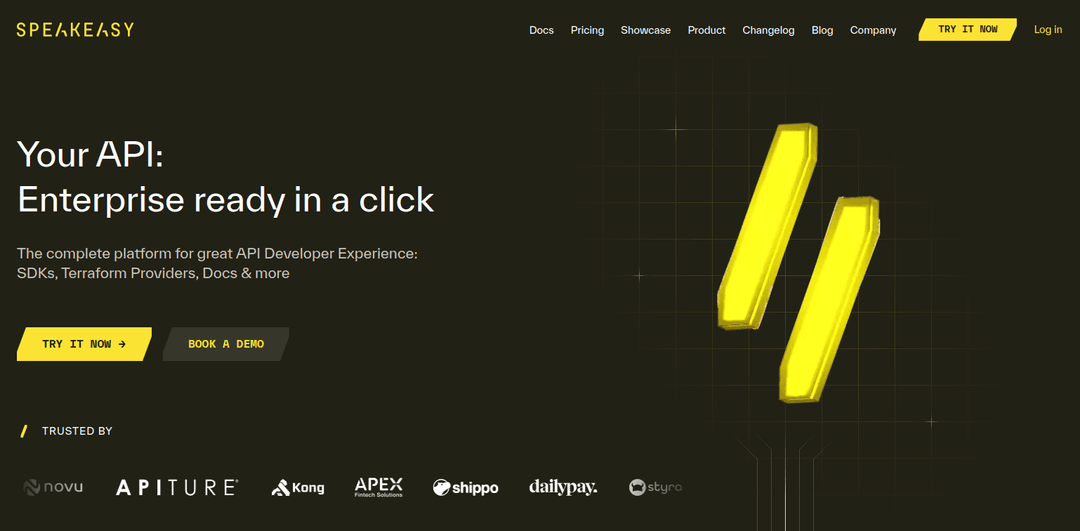
Speakeasy is designed to simplify the process of creating SDKs from your APIs. It emphasizes ease of use, allowing developers to generate SDKs quickly without delving into complex configurations. Speakeasy supports various languages and offers a user-friendly interface that caters to both experienced developers and newcomers.
Supported Languages:
Typescript
Python
Ruby
Java
PHP
Go
Pros
User-friendly interface
Quick setup and generation process
Support for multiple languages
Good documentation and community support
Cons
Limited customization options compared to other tools
May not support very complex API specifications out of the box
Use Cases:
Speakeasy is ideal for small to medium-sized and large-scale projects where quick setup and ease of use are prioritized. Companies such as Kong and Airbyte use it to foster their SDK generations. It's perfect for teams looking to integrate APIs rapidly without delving into complex configurations.
3. Stainless API:
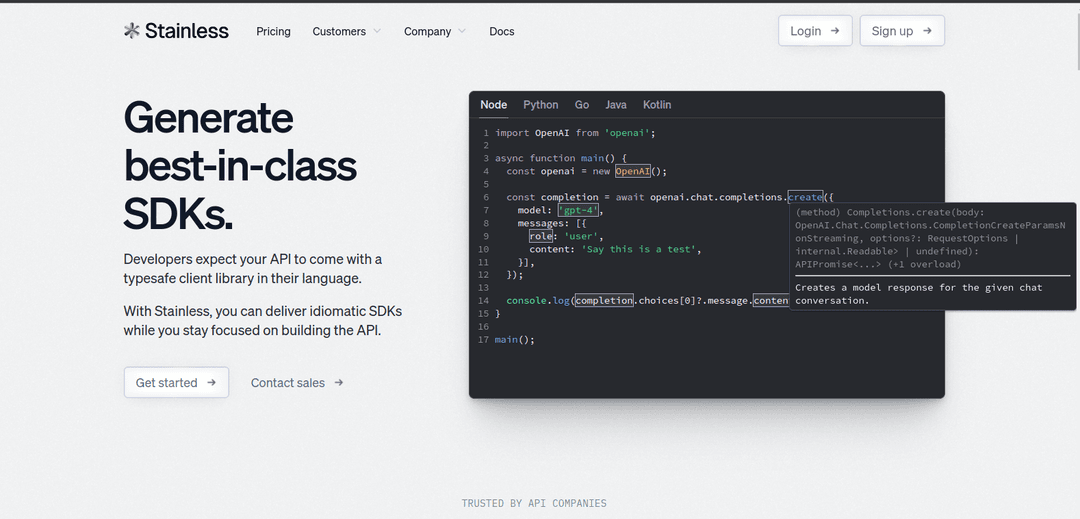
Stainless API focuses on generating high-quality SDKs that are easy to integrate and maintain. It provides robust features for customizing the generated code, ensuring that the SDKs align perfectly with your project’s requirements. Stainless API supports a wide range of programming languages and offers comprehensive documentation to help developers get started quickly.
Fun fact, Stainless was created because the co-founder was fed up with the OpenAPI Generator that they used at Stripe, so he decided to create Stainless API.
Supported Languages:
Pros:
High degree of customization
Strong focus on code quality and maintainability
Support for a wide range of languages
Comprehensive documentation
Cons:
Can be more complex to set up
Requires more initial configuration
Use Cases:
Companies such as OpenAI, Cloudflare, and Anthropic uses Stainless API, which makes it well-suited for larger projects where customization and code quality are paramount. It’s ideal for enterprises and development teams that need to ensure their SDKs adhere to specific standards and practices.
4. APIMatic
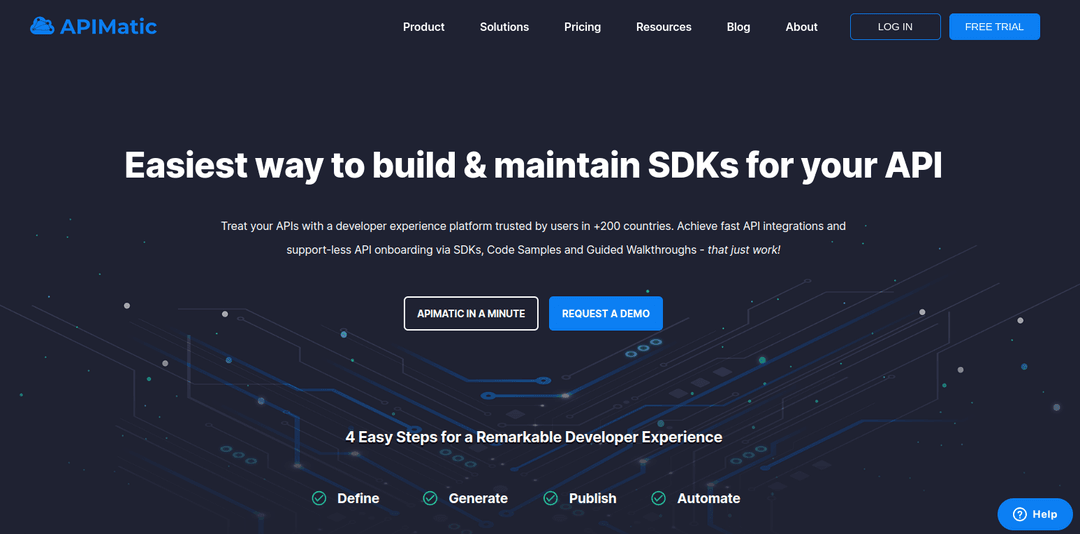
APIMatic excels in generating both SDKs and comprehensive API documentation. This dual capability ensures developers have access to both the code and the necessary usage instructions. The tool supports multiple languages and offers various customization options to tailor the generated SDKs.
Supported Languages:
- JavaScript
- Python
- Ruby
- PHP
- C#, &
- Many more.
Pros:
- Generates both SDKs and API documentation
- Supports multiple languages
- Customization options available
- Good documentation and user support
Cons:
- No free plan. Free trial only
- Can be more expensive than other tools
- Some advanced features require a learning curve.
Use Cases:
APIMatic is perfect for projects that need both SDKs and detailed API documentation. It’s suitable for businesses that prioritize developer experience and need comprehensive support materials alongside their SDKs.
5. Konfig
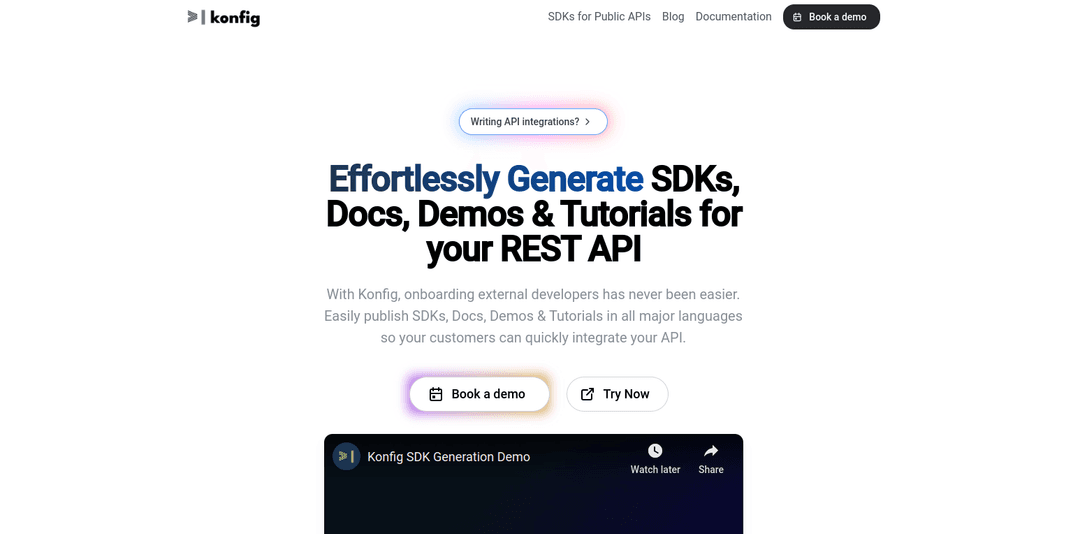
Konfig is another notable tool in the SDK generation landscape. It offers a streamlined approach to generating SDKs, focusing on simplicity and ease of use. Konfig supports a variety of programming languages and aims to help developers create consistent and reliable SDKs with minimal effort. Its intuitive interface and comprehensive documentation make it accessible to both seasoned developers and those new to SDK generation.
Pros:
- Intuitive interface
- Quick and easy setup
- Detailed documentation
Cons:
- May lack some advanced customization features
- Relatively new so support and docs may be limited.
Use Cases:
Konfig is ideal for developers and teams looking for a hassle-free way to generate SDKs quickly. It’s well-suited for small to medium-sized projects where simplicity and speed are key.
Best Practices for SDK Generation
Generating SDKs is a crucial aspect of modern software development, facilitating seamless integration with APIs and enhancing developer productivity. To maximize the benefits of SDK generation and ensure the quality and maintainability of the generated SDKs, it's essential to follow best practices. Here are some key guidelines:
Choose the Right Tool:
Selecting the appropriate SDK generation tool is the foundation of a successful SDK strategy. Consider factors such as compatibility with your API specifications, the programming languages you need to support, and the customization options offered by the tool. Tools like OpenAPI Generator and APIMatic are excellent choices for their versatility and extensive language support, while tools like Konfig, Stainliness, and Speakeasy are ideal for their simplicity and ease of use.Maintain Clear and Consistent API Specifications:
The quality of your SDKs heavily depends on the clarity and consistency of your API specifications. Use standardized formats such as OpenAPI or Swagger, and ensure that your API documentation is comprehensive and up-to-date. Clear specifications reduce ambiguity and make it easier for SDK generators to produce accurate and reliable code.Focus on Customization and Extensibility:
While SDK generators can produce boilerplate code quickly, it’s important to tailor the generated SDKs to fit your specific needs. Take advantage of customization features offered by tools like Stainless API and OpenAPI Generator to modify templates and integrate custom logic. This approach ensures that the SDKs align with your coding standards and project requirements.Ensure Comprehensive Testing: Testing is a critical component of SDK generation. Automatically generated SDKs should be thoroughly tested to verify their functionality and reliability. Implement automated tests to cover various scenarios and edge cases, ensuring that the SDKs behave as expected. Continuous integration (CI) pipelines can help automate testing and catch issues early in the development process. Konfig offers this out of the box.
Provide Detailed Documentation:
High-quality documentation is essential for the successful adoption of your SDKs. Ensure that the generated SDKs come with comprehensive usage instructions, code examples, and API references. Tools like APIMatic & Konfig excel in generating both SDKs and detailed documentation, providing developers with all the necessary information to get started quickly.Prioritize Developer Experience:
A positive developer experience can significantly impact the adoption and success of your SDKs. Focus on making the SDKs easy to install, configure, and use. Provide clear error messages, meaningful logging, and well-defined interfaces. Gather feedback from developers and continuously improve the SDKs based on their input.Keep SDKs Up-to-Date:
APIs evolve, and so should your SDKs. Regularly update the SDKs to reflect changes in the underlying APIs, such as new endpoints, parameter modifications, or deprecated features. Automated tools can help streamline this process, ensuring that developers always have access to the latest version of the SDKs.Foster a Strong Community and Support Network:
Building a community around your SDKs can provide valuable support and insights. Encourage developers to contribute to the SDKs, report issues, and share their experiences. Active community engagement can lead to continuous improvement and a richer ecosystem around your SDKs. Additionally, provide robust support channels, such as forums, chat groups, or dedicated support teams, to assist developers in resolving issues and getting the most out of your SDKs.
By following these best practices, you can ensure that your SDK generation process is efficient, the generated SDKs are of high quality, and developers have a positive experience integrating with your APIs. These principles will help you build reliable, maintainable, and widely adopted SDKs that drive the success of your software projects.
Conclusion
As the demand for seamless API integrations continues to grow, development teams must stay informed about the best practices and tools available for SDK generation. By following the guidelines outlined in this article and choosing the right SDK generation tool for their needs, developers can create reliable and maintainable SDKs that unlock the full potential of their APIs.
Whether you're a seasoned developer or just getting started with SDK generation, the insights provided in this guide will help you navigate the complexities of API integration and empower you to build cutting-edge applications that drive innovation and success.